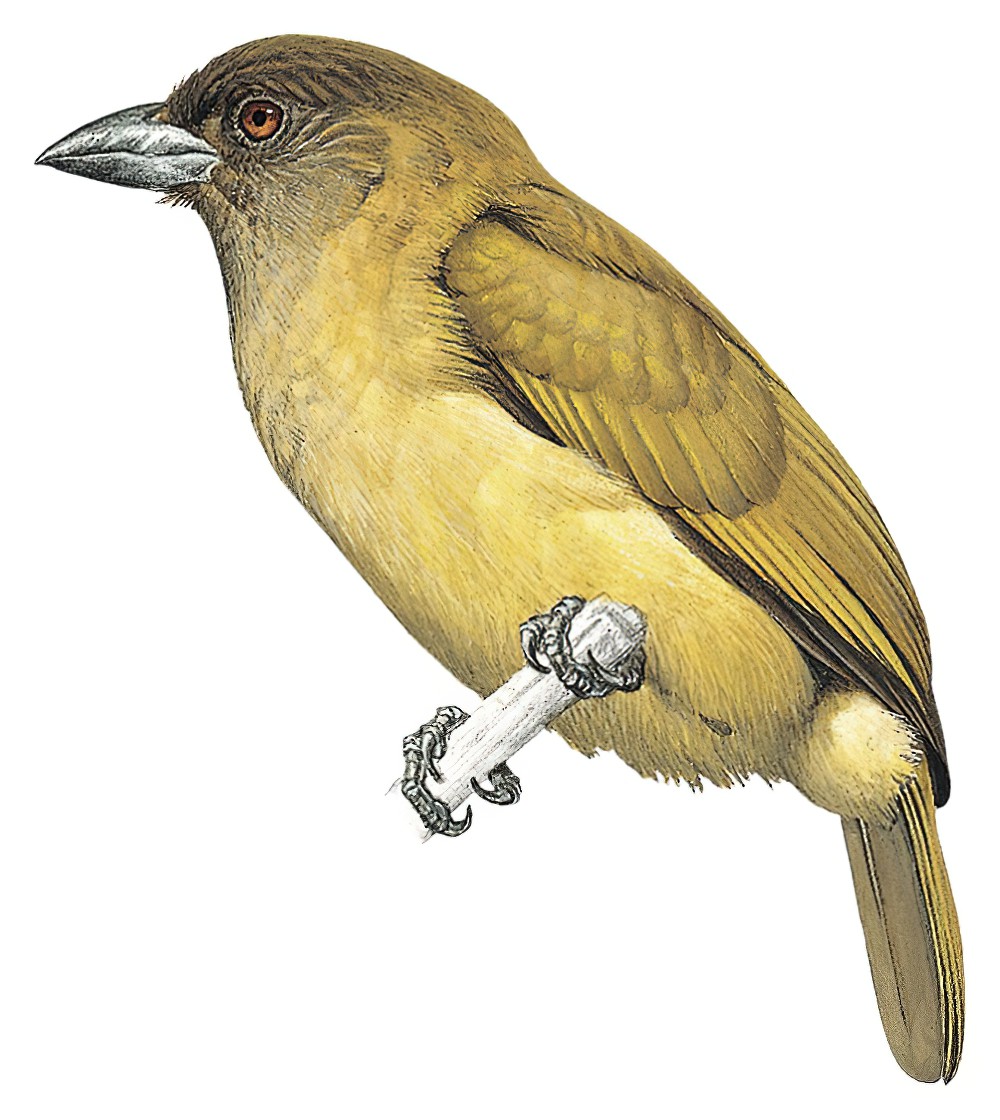Green Barbet / Stactolaema olivacea

Green Barbet
SCI Name:
Protonym: Barbatula olivacea Ibis p.334 pl.7
Taxonomy: Piciformes / Lybiidae / Stactolaema
Taxonomy Code: grebar2
Type Locality: Rabbai, near Mombasa, Kenya Colony.
Author: Shelley
Publish Year: 1880
IUCN Status: Least Concern
DEFINITIONS
STACTOLAEMA
(Lybiidae; Ϯ Yellow-headed Barbet S. anchietae) Gr. στακτος staktos trickling, dropping < σταζω stazō to drip; λαιμος laimos throat; "gutture et pectore longitudinaliter sulphureo striatis" (Barboza du Bocage 1869); "The ornithology of Africa, on the other hand, is considerably less developed, the opportunities for study and research being few and precarious; it contains types of all three subfamilies, and nearly half of the known species, including the most aberrant forms, are found there: among these is one species which we are unable to identify with any of the received generic types, and which presents sufficient structural peculiarities to found a new genus, for which we propose the following name and diagnosis:— STACTOLÆMA. Type S. anchietæ (fig. 1, p. 119). 1. Rictal bristles rudimentary or wanting. 2. Bill with the margin smooth. 3. Culmen acute, inflated. The first and second features identify it with the subfamily of Capitoninæ; the third distinguishes it from Caloramphus and the remaining genera. S. anchietæ is the only species as yet known" (C. Marshall & G. Marshall 1870).
Synon. Smilorhis.
olivacea
Mod. L. olivaceus olive-green, olivaceous < L. oliva olive.
● ex “Olivert” of Levaillant 1803, pl. 125 (syn. Camaroptera brachyura).
● ex “Olivet” of de Buffon 1770-1783, and “Olive Tanager” (= ♀) of Latham 1783, and Pennant 1785 (Piranga).
● ex “Olive-coloured Warbler” of Brown 1776, and Latham 1783 (unident.).
● ex “Promérops olivâtre” of Audebert & Vieillot 1800-1802 (unident.; Meliphagidae).
SUBSPECIES
Green Barbet (Green)
SCI Name: Stactolaema olivacea olivacea
olivacea
Mod. L. olivaceus olive-green, olivaceous < L. oliva olive.
● ex “Olivert” of Levaillant 1803, pl. 125 (syn. Camaroptera brachyura).
● ex “Olivet” of de Buffon 1770-1783, and “Olive Tanager” (= ♀) of Latham 1783, and Pennant 1785 (Piranga).
● ex “Olive-coloured Warbler” of Brown 1776, and Latham 1783 (unident.).
● ex “Promérops olivâtre” of Audebert & Vieillot 1800-1802 (unident.; Meliphagidae).
Green Barbet (Howell's)
SCI Name: Stactolaema olivacea howelli
howelli
● Arthur Holmes Howell (1872-1940) US ornithologist, mammalogist, collector (syn. Ammospiza maritima fisheri, subsp. Chordeiles minor).
● Prof. Kim Monroe Howell (b. 1945) US zoologist, marine biologist, at University of Dar es Salaam, Tanzania (subsp. Cryptolybia olivacea).
Green Barbet (Woodward's)
SCI Name: Stactolaema olivacea woodwardi
woodwardi
• Bernard Henry Woodward (1846-1916) British immigrant to Australia, son of Prof. S. P. Woodward, assayer, Curator of Perth Mus., Western Australia 1889-1916 (Amytornis, subsp. Anthochaera carunculata, Colluricincla, syn. Dromaius novaehollandiae, syn. Eudyptula minor novaehollandiae, subsp. Mirafra javanica, syn. Porphyrio melanotus).
• Dr Sir Arthur Smith Woodward (1864-1944) English palaeontologist involved in the Piltdown Man hoax 1912 (‡Buteo).
• Revd. Richard Blake Woodward (1847-1919) and his brother Revd. John Deverell Stewart Woodward (1849-1919) English missionaries to Natal, naturalists, explorers, collectors, emigrated to Australia 1905 (Paul Scofield in litt.) (subsp. Cryptolybia olivacea, subsp. Sylvia borin).
Green Barbet (Malawi)
SCI Name: Stactolaema olivacea belcheri/rungweensis
STACTOLAEMA
(Lybiidae; Ϯ Yellow-headed Barbet S. anchietae) Gr. στακτος staktos trickling, dropping < σταζω stazō to drip; λαιμος laimos throat; "gutture et pectore longitudinaliter sulphureo striatis" (Barboza du Bocage 1869); "The ornithology of Africa, on the other hand, is considerably less developed, the opportunities for study and research being few and precarious; it contains types of all three subfamilies, and nearly half of the known species, including the most aberrant forms, are found there: among these is one species which we are unable to identify with any of the received generic types, and which presents sufficient structural peculiarities to found a new genus, for which we propose the following name and diagnosis:— STACTOLÆMA. Type S. anchietæ (fig. 1, p. 119). 1. Rictal bristles rudimentary or wanting. 2. Bill with the margin smooth. 3. Culmen acute, inflated. The first and second features identify it with the subfamily of Capitoninæ; the third distinguishes it from Caloramphus and the remaining genera. S. anchietæ is the only species as yet known" (C. Marshall & G. Marshall 1870).
Synon. Smilorhis.
UPPERCASE: current genus
Uppercase first letter: generic synonym
● and ● See: generic homonyms
lowercase: species and subspecies
●: early names, variants, mispellings
‡: extinct
†: type species
Gr.: ancient Greek
L.: Latin
<: derived from
syn: synonym of
/: separates historical and modern geographic names
ex: based on
TL: type locality
OD: original diagnosis (genus) or original description (species)












